Perfect no knead sourdough bread is amazingly easy to make and have on hand anytime. Rather than kneading it by hand to create a lovely texture, the bread dough rests over a period of time, yielding similar results without all of the hard work.

You may have heard of the miracle no knead bread of New York times fame. This easy sourdough bread is inspired by that famous bread, however instead of instant yeast a small amount of active sourdough starter is used to leaven the bread and to give it a delicious flavor.
The result is the easiest sourdough bread I have ever made, with minimal hands on time and few steps. A perfect recipe for sourdough baker beginners.
The Purpose of Kneading Sourdough Bread
Typically, sourdough bread and many other types of bread require kneading or at least a sequence of stretch and folds. The purpose of this process is to work the dough to make it more of a homogenous mixture and develop the gluten to improve the structure of the dough. Developing the gluten means that you will be untangling the proteins that become tangled when you mix the dough, then weaving them together to form a stronger structure.
A properly kneaded and developed bread dough will be better able to trap the gasses that the yeast produces in pockets, thus allowing for a nice even rise in the oven. On the other hand, a dough that hasn't undergone enough kneading may result in a flatter, tougher-textured loaf. The result of a properly kneaded dough is one that rises evenly in the oven, has nice air pockets in the interior when the bread is sliced, and a light and airy crumb.
Luckily, for those who don't enjoy the workout that kneading bread offers, here is a no knead, easy sourdough bread recipe that offers similar results with minimal effort.

How No Knead Sourdough Bread Works
No knead sourdough bread doesn't require any kneading at all. Instead, all of the ingredients get mixed together in a large mixing bowl and covered to ferment for 12 to 18 hours. For the covering, you can use either a plate, plastic wrap, lid, or eco-friendly bowl cover. Even a tea towel fastened with an elastic over the bowl would work well. During this time, the proteins that you would normally untangle and realign during kneading, get broken down in a process called autolysis. Technically, the enzymes in the flour break down the proteins in the flour, while the natural yeast in the starter does the "kneading."
Ingredients for No Knead Sourdough Bread
The ingredient list for this no-knead sourdough bread recipe is relatively simple. All you will need is an active sourdough starter, water, all-purpose flour, and salt to begin making this bread. As a result, although no knead sourdough bread requires more effort than purchasing a loaf of bread from the store, you will potentially be making something that is healthier and higher quality at a more affordable price.
How to Make No Knead Sourdough Bread
Leaven
To begin making this sourdough recipe, you will need to begin with an active sourdough starter. This means that the sourdough starter should have undergone a few feedings at room temperature, have a slightly sour smell, is bubbly, and has doubled in size since its last feeding. You can either use my rye sourdough starter recipe to create your own starter or use a sourdough starter that you have on hand already. This starter will replace the commercial yeast that is often used in bread recipes.
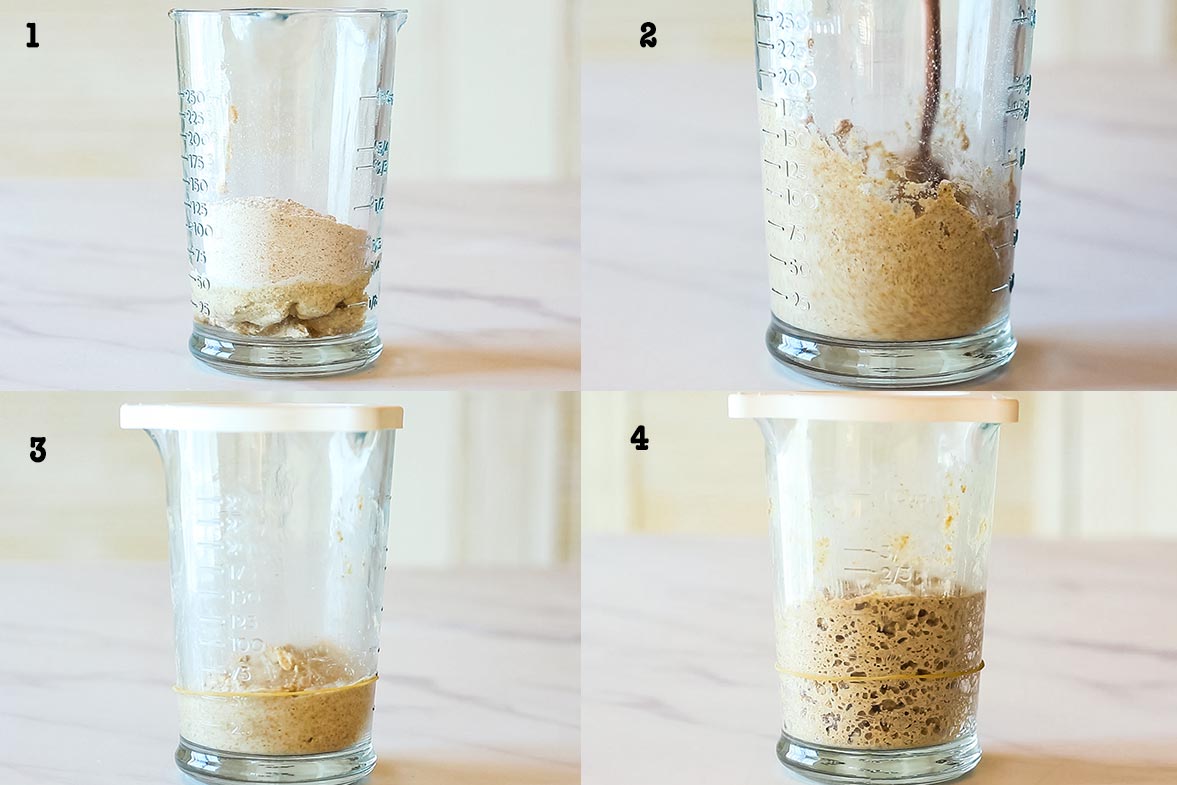
1. This recipe requires 50 grams of active starter. So I start by adding 15g of my previous starter, 25g of filtered water and 25g of rye flour to a jar.
2. Stir well until everything is fully combined.
3. Scrape down the sides of the jar. Cover loosely with a lid or paper towel and an elastic band. Attach another elastic band around the jar to make the initial dough line.
4. Within the next 6-10 hours the starter should bubble up and at least double in size.
Mixing the Dough
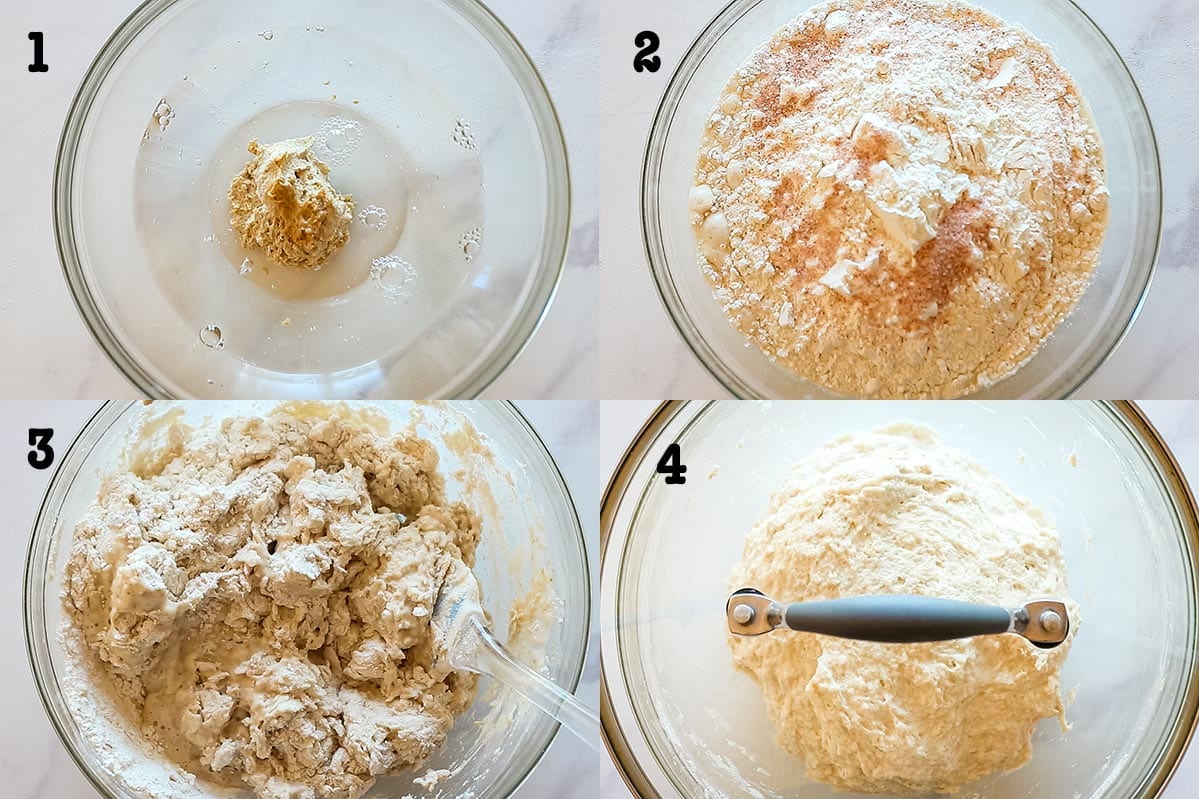
1. Once your starter is active, place it in a large bowl and whisk it together with the water to ensure it is combined.
2. Then, add the flour and salt.
3. Stir it together with either a wooden spoon or spatula just until you don't see any streaks of flour.
4. Then, you cover the bowl with the dough mixture with a lid, towel, or plastic wrap. Allow the bowl to sit at room temperature for 12 to 18 hours.
Shaping the Dough
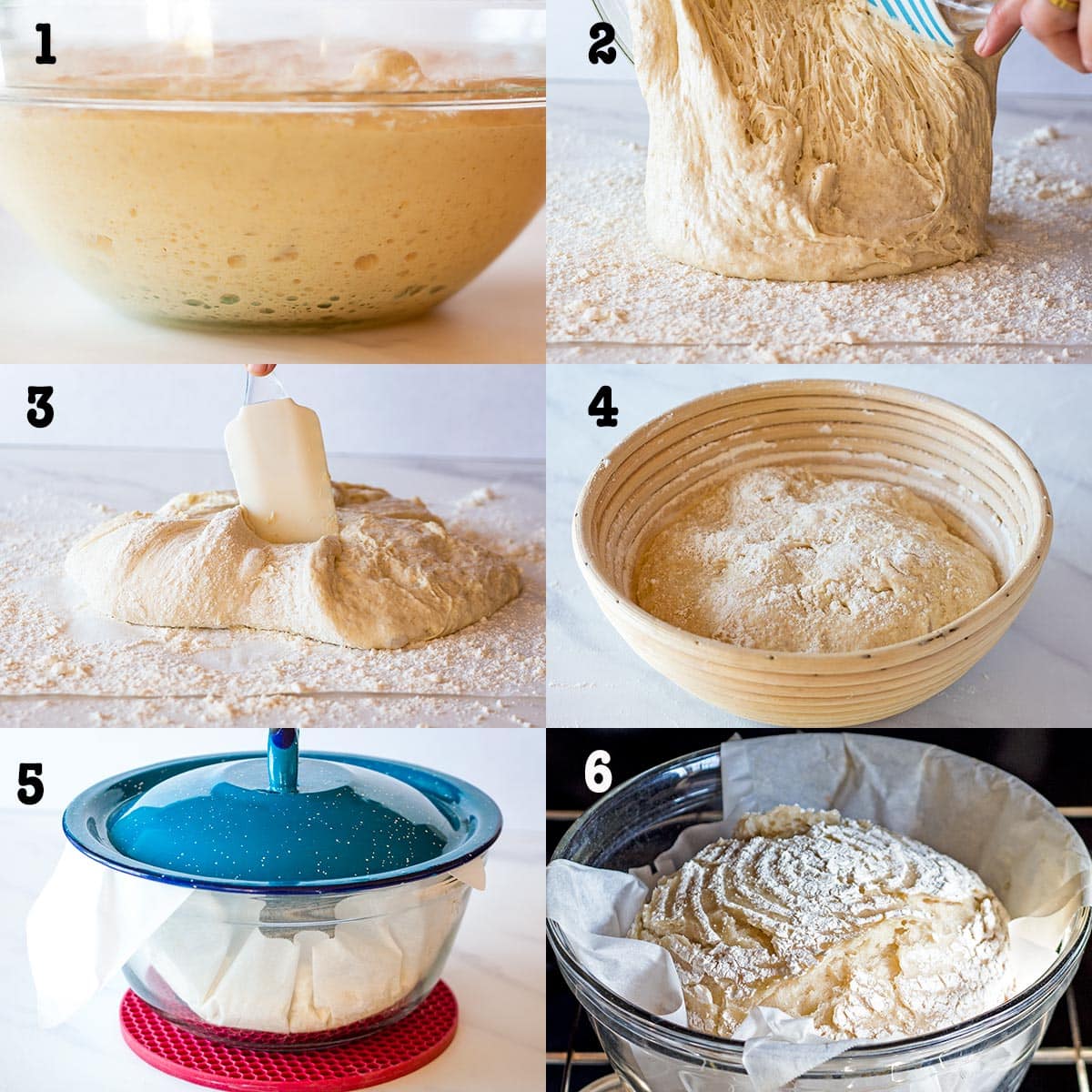
1. Once the dough has properly fermented, it will look at least doubled in size, looser, stretchier, and wetter than what you began with. If you used a glass bowl, you will see lots of air bubbles in the dough.
When you are ready to bake your sourdough bread, you should preheat your oven to 450°F. Then, place either a Dutch oven or oven-safe glass pyrex bowl in the oven to warm up for 30 minutes.
2. Next, dust a piece of parchment paper with flour, like all-purpose flour or bread flour. Then, using a spatula or a dough scraper, scrape the dough out of the bowl and onto the paper.
3. Shape the loose dough into a tighter ball with either wet hands or a spatula/dough scraper.
4. Optionally, you can rest the dough boule seam side up in a banneton basket, if you have one, until the oven preheats. How give the bread more but retarted fermentation time in the fridge for a stronger sourdough taste.
5. Otherwise, lift the parchment paper with the dough and lower it into the heated bowl or pot. While you don't have to do so, you can score the top with either a sharp knife or lame before baking. This will ensure the bread has a more even rise and give it an attractive appearance.
Cover the bowl/pot with a lid or aluminum foil. Covering will add steam to the baking process which is ideal for producing a nice crackly, crispy crust.
Baking the Bread
6. Then, after the 25 minutes, you remove the lid and allow it to bake until golden and crusty.
Once the bread is done, remove it from the oven and the bowl/pot. Allow it to cool completely (on a wire rack) before slicing into it.
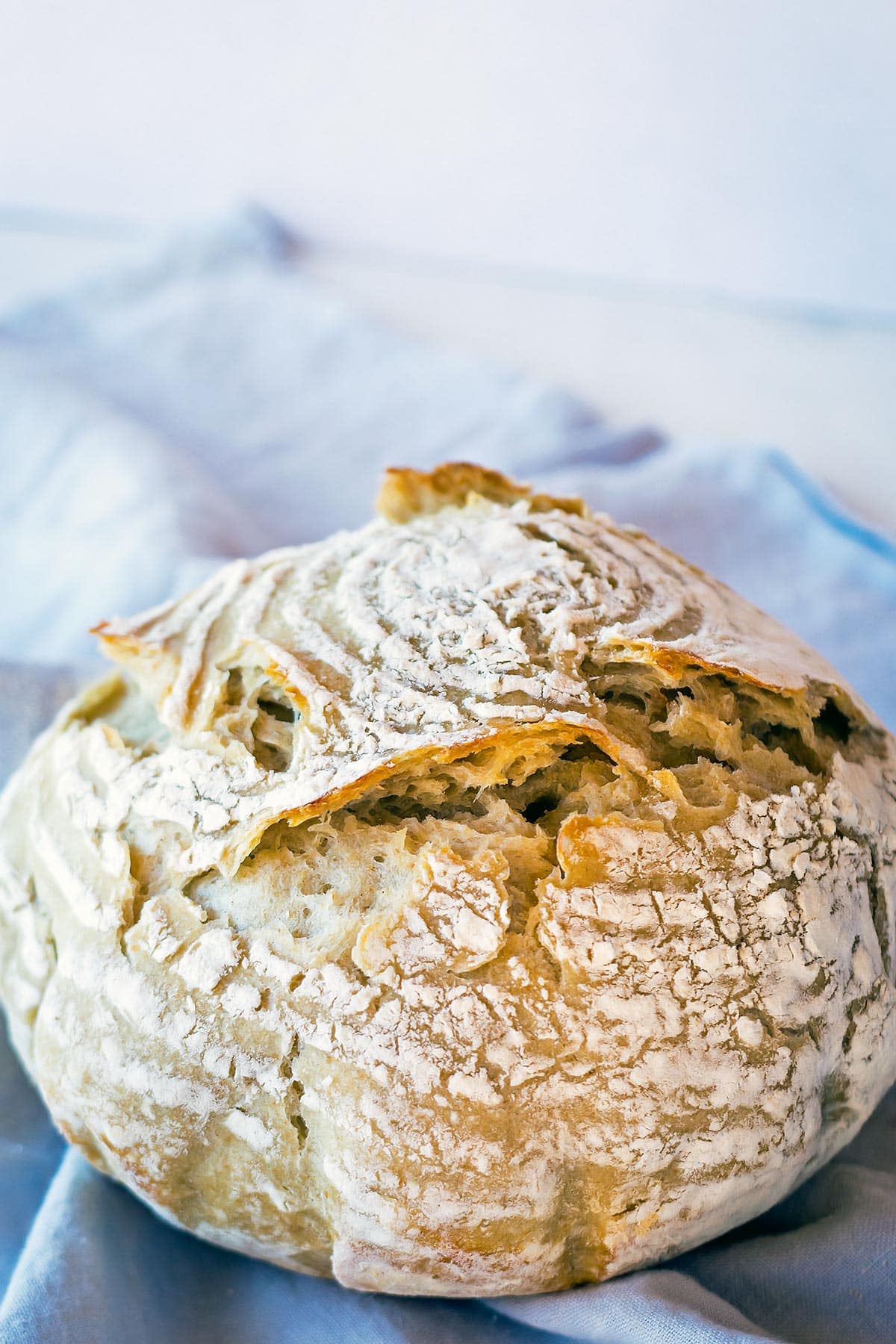
How to Enjoy No Knead Sourdough Bread
While homemade artisan sourdough bread is perfect on its own with butter, there are a multitude of ways to enjoy it. Here are some ideas.
- Use it for sandwiches such as ham and swiss or a classic BLT.
- Toast it for bread and add your favourite jam, honey, jelly, butter, or nut or seed butters.
- Use up older sourdough bread for homemade stuffing to go with your holiday turkey.
- Slice it very thinly, brush it with olive oil, and toast it in the oven before using as a base for bruschetta or crostini.
- Turn into croutons, toasted in the oven with olive oil, dried herbs, and garlic.
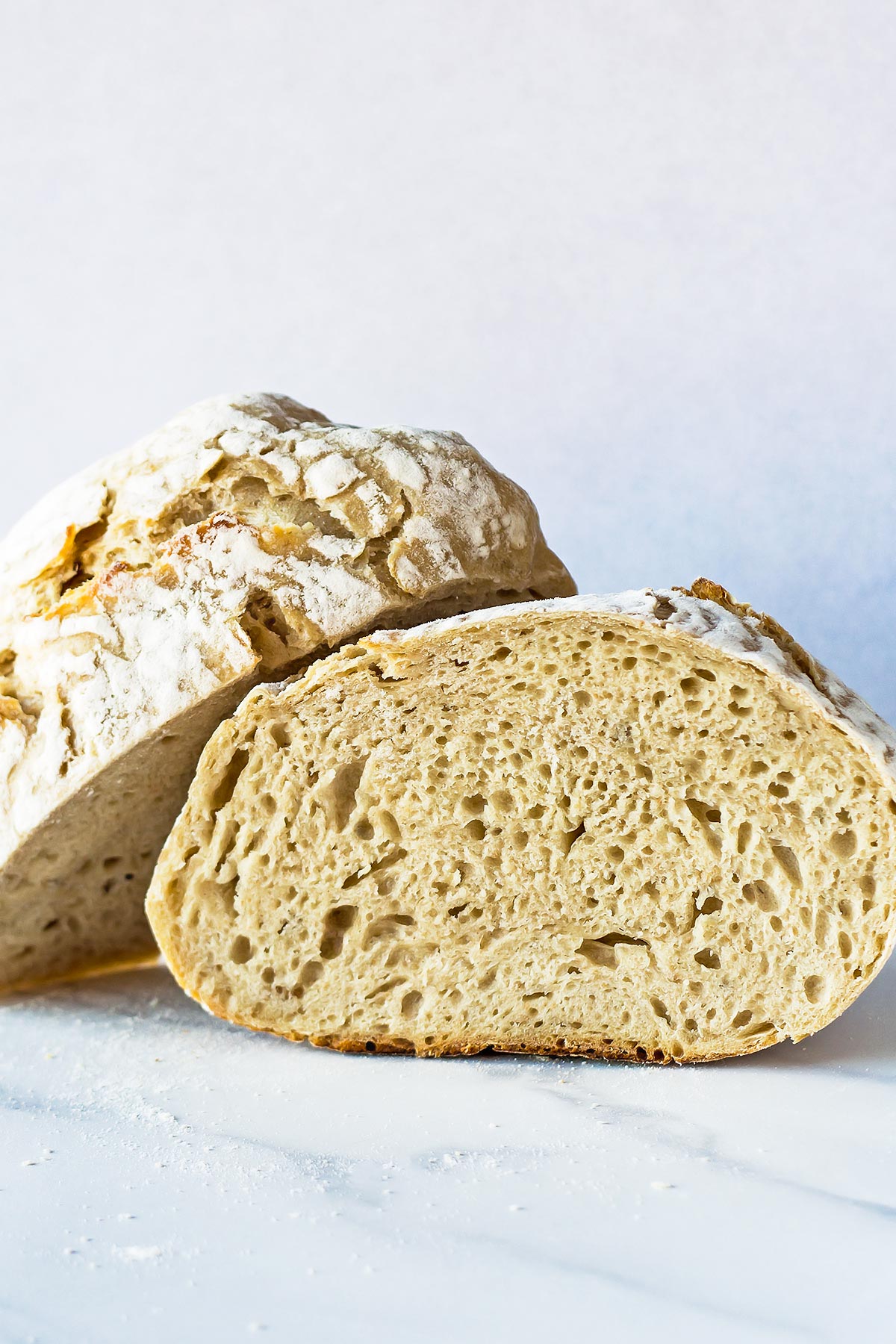
Storing Sourdough Bread
Undoubtedly, fresh sourdough bread is best enjoyed within the first day or 2 after baking. You can store it at room temperature in a bread box, covered with a towel, or in an airtight container.
To store longer, slice up the entire loaf and store the slices airtight in the fridge. Toast refrigerated slices to give them some warm crustiness before eating.
Sliced up, you can also freeze your bread. Remove individual slices as needed and thaw them in the toaster.
More Bread Recipes You'll Love:
- Gluten Free Cornbread
- Beer Bread
- Best Coconut Flour Bread
- Multigrain Sourdough Bread
- No Knead Bread
- Soft Sandwich Bread
Recipe
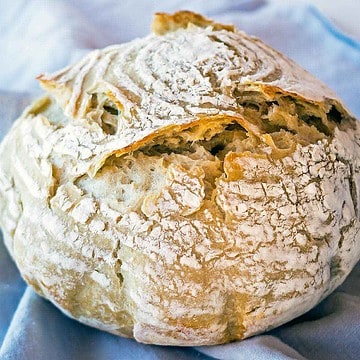
No Knead Sourdough Bread - easy, without Dutch oven
Equipment
- Oven-safe glass bowl (like Pyrex) or Dutch Oven
Ingredients
- 50 g active sourdough starter * I use rye starter (even unfed discard works)
- 350 g water filtered
- 450 g all-purpose flour preferably unbleached
- 9 g salt
Instructions
- In a large mixing bowl whisk together the sourdough starter and filtered water until lightly frothy and well combined.
- Add in the flour and salt. Stir and fold everything together with a rubber spatula. Stir just until you don't see any more dry flour.
- Cover the bowl with a lid, large plate (plastic wrap as last resort) and let the bread ferment at room temperature for 12-18 hours.
- Preheat your oven to 450°F for 30 minutes with a large, oven-safe glass bowl (Pyrex) inside (or Dutch oven if you have).
- Sprinkle a generous amount of flour onto a piece of parchment paper. Using a spatula scrape the dough onto the flour parchment.
- The dough will be quite sticky, so I like to use my spatula (but you can also use wet hands) to gently fold in the sides of the dough mass to form a rough ball shape**. Optionally, you can rest the dough ball in a sourdough banneton for about ½ hour until the oven is preheated.
- Using oven mitts remove the preheated glass bowl from the oven. Lift the parchment paper with the sourdough bread ball and lower it into the bowl. Optionally, score the top with a sharp knife or lame.
- Cover with an oven-safe lid or aluminum foil. Return the bowl to the oven (carefully, with oven mitts) and bake the bread covered for 25 minutes.
- Then remove the cover and bake another 15-20 minutes. The should be golden brown with a crunchy crust. The internal temperature should reach at least 190°F.
- Remove the bread from the oven and from the bowl. Let it cool to room temperature before slicing. Or tear right in, if you are going to enjoy some crusty bread with a hearty soup or stew.
- Keep this easy no-knead sourdough bread at room temperature for 3-4 days in an airtight bag, container, or bread box.
Notes
Nutrition
Pin for later?
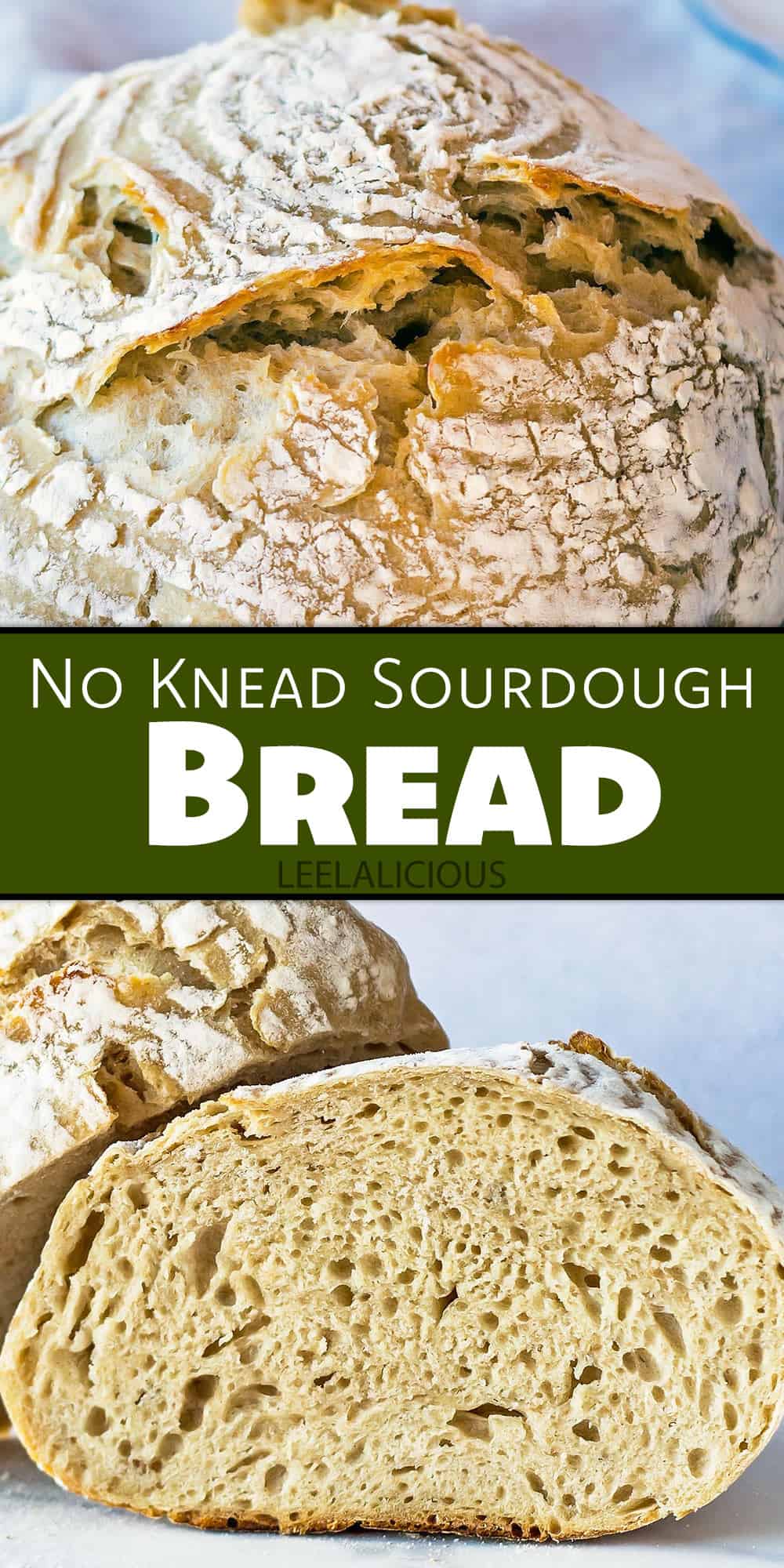
Random Questions
Traditional sourdough often requires kneading to develop gluten for a better structure. No knead sourdough relies on time and natural enzymes to achieve similar results without manual kneading.
No knead methods, like this recipe, use autolysis during the resting period, breaking down proteins and letting natural yeast do the "kneading," resulting in a similar texture.
No knead bread simplifies the process, relying on time and minimal effort for gluten development. It's an easier method for beginners, producing flavorful and textured loaves.
For many, the no knead method offers simplicity without sacrificing taste or texture, making it an excellent option, especially for those new to sourdough baking.


Crystal Virgin
How large does the glass bowl need to be? I've got about a medium sized mixing bowl, maybe a little larger.
Jennifer @ Leelalicious
You should use a large bowl for mixing the dough as it is roomier and easier to mix all the ingredients in. It also gives the dough room to expand as it sits. However, if you have a large Dutch oven or similar-sized pot, that could work, too.
Andrea
Can I mix this recipe with a different flour not only then all-purpose flour?
Regina | Leelalicious
Yes absolutely. In fact I have a multigrain version of this bread recipe here https://leelalicious.com/multigrain-sourdough-bread/
I recommend using up to 200g of a different flour. Either whole wheat, spelt, rye, etc.
nina
Super easy to follow, turned out delicious!!!!
Jennifer @ Leelalicious
Thank you for your positive review, Nina! 🙂